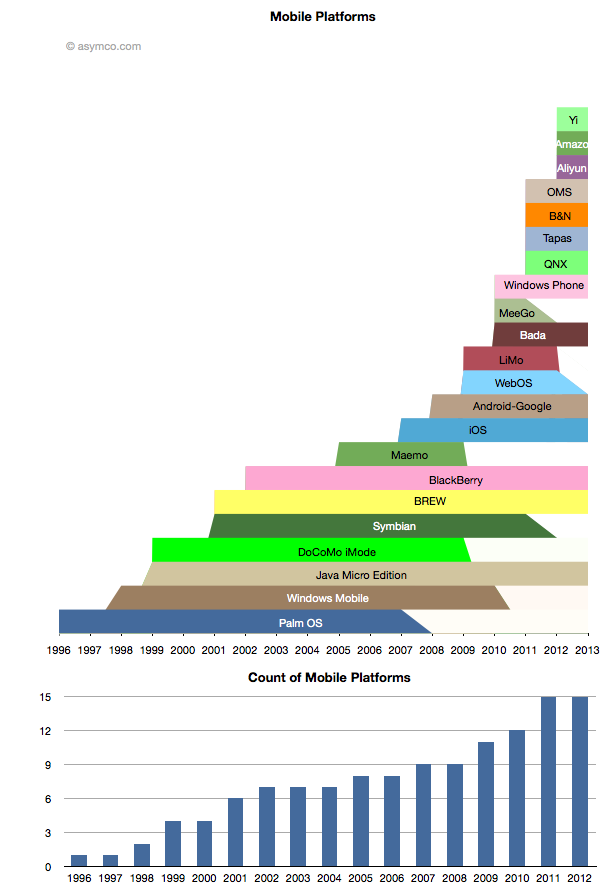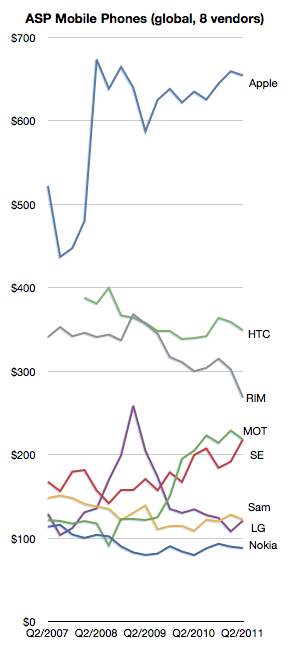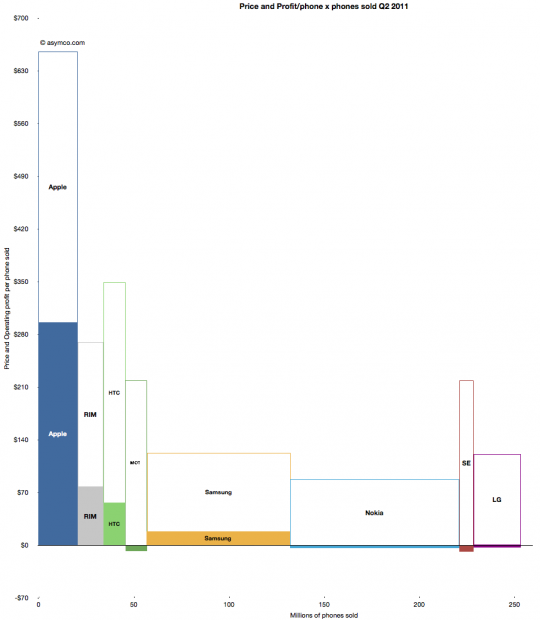While some mobile platforms are being withdrawn from the market, others are being introduced. The net is that there are more mobile platforms announced for 2012 than ever before. The following chart shows the lifespan of the platforms that I can recall.[1]
Category: Industry
Mobile Computing Industry
US smartphone penetration growth rate update
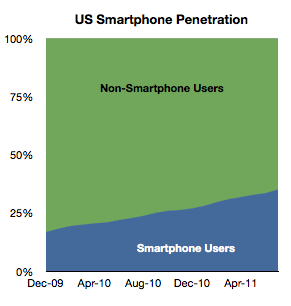
The survey data from comScore is in and it suggests that smartphone penetration increased by a significant 1.58%. It is now 35.1% with 82.2 million users.
The weekly new user rate was about 863k/wk during July or about 586k/wk average over the last three months. I plotted the weekly add rates for the last 18 surveys and overlaid the three month moving average.
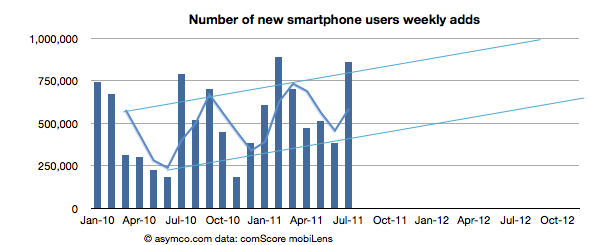 The chart shows that there is an upward slope to the upper and lower bounds of the moving average. Extrapolating trend forward gives me confidence in projecting 50% penetration by July 2012.
The chart shows that there is an upward slope to the upper and lower bounds of the moving average. Extrapolating trend forward gives me confidence in projecting 50% penetration by July 2012.
Samsung's Polyplatform Paradox
Samsung has, over the years, shipped phones using almost every operating system it could get a hold of. That includes Symbian, Windows Mobile, Windows Phone, LiMo, Android, PalmOS and OPhone.
As far as I know, today its portfolio includes Android, Windows Phone and its own Bada OS. The relaxed attitude to platform exclusivity at Samsung is in stark contrast with almost all other competitors who either for the sake of encouraging their own platforms or minimizing development costs maintained either one or two smartphone platforms.
Samsung justified their polyplatform strategy a few years ago by saying that different platforms are popular in different regions and as they did not want to be excluded from any market, they felt that being agnostic is the best policy.
The idea that platforms are not universal, but the result of provincial preferences is interesting. It’s a concession that “politics” plays a large part in mobile markets. However, for all the volume growth the strategy has produced, the strategy has not paid off in terms of higher margins or pricing power as the following chart shows.
Is LG about to exit the phone market?
LG’s market position seems precarious. I first noted LG’s predicament about a year ago: LG dreams of smartphones [Updated] | asymco
LG lost profitability in Q3 2009 and has not recovered it yet nor can it say when it might.
In a recent article on analyst reactions the prospect of LG’s exit from handset sales is raised:
LG’s handset division is the company’s biggest capital sinkhole and the shares have more than halved this year, making it the worst performer even when compared to HTC and Nokia.
“Selling the loss-making business is probably what investors want,” said Harrison Cho, an analyst at KB Investment & Securities. “But even with that option, LG wouldn’t get much from the sale. They should have sold it long ago before the overall landscape got tougher.”
“They simply missed the boat,” said Cho.
The dire business outlook had already pushed LG shares below their book value to a record-low multiple of 0.9 times its book value, much cheaper than Research In Motion’s 1.6 times, Nokia’s 1.1 and HTC’s 8.2.
That’s a huge discount for a company that is also a global brand in television and home appliances.
Analysis: LG faces tough choices for mobile phone division – Yahoo! Finance Continue reading “Is LG about to exit the phone market?”
Google's Strategic Mistakes Drove Motorola Buy – Horace Dediu – Harvard Business Review
My thanks to Eric Hellweg, HBR editor, for offering the opportunity to write in the Harvard Business Review blog and the help in editing and sharpening the message.
You can read the article here:Google’s Strategic Mistakes Drove Motorola Buy – Horace Dediu – Harvard Business Review.
Please use the forum at hbr.org for discussion.
The perils of licensing to your competitors
Google’s acquisition of Motorola is clearly designed to be an acquisition of Intellectual Property rather than an entry of Google into the phone business, but the impact on the business will be felt in many ways.
It is surely going to send some Android vendors scrambling. The situation is not without precedent however. The history of governance and ownership of Symbian shows how the licensing of platforms by licensor competitors leads to unintended consequences.
Symbian was formed to be governed in a way very similar to the original Android via the Open Handset Alliance. The company was owned by a consortium of phone vendors.[1] The shares were not equally distributed however with Nokia holding a larger share (though not a majority).
Although nominally involved in decision making, the smaller shareholders never felt entirely comfortable with the arrangement and over time some sold their shares and left the group even though they continued to license the OS.
Eventually Nokia ended up acquiring the company outright and open sourced the code. However, by then the product was obsolete and the only licensee was Nokia itself.
The lesson (and warning) was that a licensor that is also a licensee makes other licensees uncomfortable. The supplier is also a competitor. This is classic channel conflict and never ends well.
Open or not, with or without equity, these arrangements are always unworkable.
So Google’s promise that
“This acquisition will not change our commitment to run Android as an open platform. Motorola will remain a licensee of Android and Android will remain open. We will run Motorola as a separate business. Many hardware partners have contributed to Android’s success and we look forward to continuing to work with all of them to deliver outstanding user experiences.”
seems naive at best.
—
Notes:
- Before its outright purchase by Nokia in December 2008, Symbian Ltd. was owned by Nokia (56.3%), Ericsson (15.6%), Sony Ericsson (13.1%), Matsushita (10.5%), and Samsung (4.5%). The company’s founder shareholders were Psion, Nokia, Ericsson, Panasonic/ Matsushita and Motorola. Motorola sold its stake in the company to Psion and Nokia in September 2003. Psion’s stake was bought by Nokia, Matsushita, Siemens AG and Sony Ericsson in July 2004.
A motion chart for the mobile phone market
The charts published here typically show data across two dimensions, (X-axis and Y-axis). Since many times we have to look at data over these dimensions and through time, there are no easy ways to do it without some iteration of the same chart.
As an alternative a “Motion Chart” let you look at data across up to five dimensions (X-axis, Y-axis, Color, Size and Time). This is a dynamic flash-based chart that allows you to explore several industry/vendor indicators over time. You can:
- Select x-axis from seven options
- Select y-axis from five options
- Select type of chart (tabs in the upper right of chart: bubble, bar, line)
- Set color from several variables
- Set bubble size from several variables
- Select to track individual companies (and enable tracks or trails that trace the patch of individual bubbles)
- Play through time (and change playback speed)
- Scrub through time manually over any time range
- Mouse-over any data point for the actual values it represents in all dimensions (mouse-over and click to select to track that vendor)
This data and chart are updated and available at higher resolution at the following (permanent) location: https://www.asymco.com/hire-me/vendor-bubbles/
[hang2column foo=”bar”]
[/hang2column]
Mobile phone market evolution: An animated view
I took the stacked cascade chart of profit/phone x phones sold into a multi-quarter animation subtitled “The evolution of Shipments, Revenue, Profitability and Cost structure of eight vendors selling mobile phones between second quarter 2007 and second quarter 2011.”
(I recommend selecting 1080p HD view and full screen to sufficiently resolve details.)
httpv://www.youtube.com/watch?v=Vg8idQCc1D8
The Mobile Marshalling Yard
The phone vendors’ ranking relative to each other on three measures of share (Unit or Volume, Revenues and Operating Profit) is shown below:
Although not much changed in the unit rankings since last quarter, revenues did see Samsung and Nokia trade places. In the case of Profitability, the chart shows a sparseness that is quite unprecedented. Only positive profit figures are charted.
A new view into the phone market
The profitability (aka Profit/Phone x Phones Sold, aka Rawr) chart is a great way to see the “shape” of the industry at a glance, with attention to volume and profitability.
What is missing however is a perception of the sales level and the pricing of the products. To help in that regard, I prepared an extension to the profitability chart which covers the price and sales for each participant.
You can interpret this graph as an extension of the profitability chart where the “empty” or white areas above each profit area are payments to suppliers and operating expenses. Thus the sum of empty and filled areas (above zero) are equivalent to revenues. If the sum of the empty and filled areas are greater then revenues (i.e. they extend below zero) then the difference is operating losses.
The top of both empty and filled rectangles are set at the average selling price per phone (and the top of each filled rectangle is the operating profit per phone). The width of both rectangles is the volume of phones shipped.
The things you can read into this chart are: Continue reading “A new view into the phone market”

